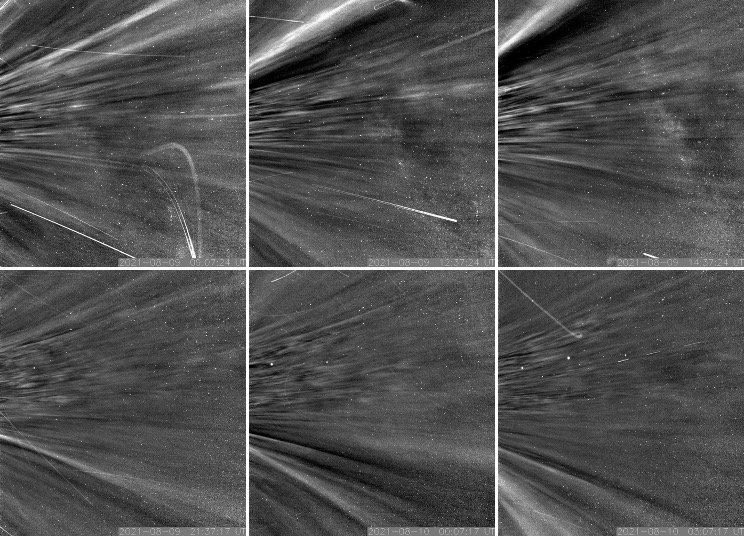For The First Time in History, a
Spacecraft Has 'Touched' The Sun
15 DECEMBER 2021
In an incredible historic first, a human-made spacecraft has swooped in and made contact with the Sun.
On 28 April 2021, NASA's Parker Solar Probe actually flew into and through the solar corona, the upper atmosphere of the Sun. Not only did it live to tell the tale – proving the efficacy of Parker's high-tech heat shielding – it took in situ measurements, giving us a wealth of never-before-seen data on the heart of our Solar System.
"Parker Solar Probe 'touching the Sun' is a monumental moment for solar science and a truly remarkable feat," said astrophysicist Thomas Zurbuchen, associate administrator for the Science Mission Directorate at NASA Headquarters.
"Not only does this milestone provide us with deeper insights into our Sun's evolution and its impacts on our Solar System, but everything we learn about our own star also teaches us more about stars in the rest of the Universe."
Parker Solar Probe launched in 2018, with its primary objective to probe the solar corona. In its planned seven-year mission, it should be making a total of 26 close approaches, or perihelions, to the Sun, using a total of seven gravity assist maneuvers from Venus to bring it ever closer. The April perihelion was the eighth, and the first to actually enter the corona.
In its nearly five hours inside the solar atmosphere, Parker measured fluctuations in the Sun's magnetic field and sampled particles. Previously, our estimates of these properties relied on external information.
"Flying so close to the Sun, Parker Solar Probe now senses conditions in the magnetically dominated layer of the solar atmosphere – the corona – that we never could before," said astrophysicist Nour Raouafi, Parker project scientist at the Johns Hopkins Applied Physics Laboratory.
"We see evidence of being in the corona in magnetic field data, solar wind data, and visually in images. We can actually see the spacecraft flying through coronal structures that can be observed during a total solar eclipse."

(NASA/Johns Hopkins APL/Naval Research Laboratory)
Above: The bright features visible in the pictures here are coronal streamers, normally only seen from Earth during an eclipse. These were imaged by the Parker probe during the ninth perihelion in August this year.
The Sun doesn't have a solid surface. Instead, its boundary is defined by what we call the Alfvén critical surface, where gravity and the Sun's magnetic fields are too weak to contain the solar plasma.
Above this point, the solar wind emerges, blowing powerfully through the Solar System, so fast that waves within the wind break away from the Sun. What we call the 'surface' of the Sun, composed of roiling convection cells plasma and known as the photosphere, is far below.
One of the goals of Parker was to find out more about the Alfvén critical surface; namely, where it is, and what its topography is like, since we didn't know either of those things. Estimates had put the Alfvén critical surface at somewhere between 10 and 20 solar radii from the center of the Sun. Parker entered the corona at 19.7 solar radii, dipping down to as low as 18.4 solar radii during its corona jaunt.
Interestingly, the probe seemed to encounter the magnetic conditions of the corona sporadically, suggesting that the Alfvén critical surface is wrinkled. At lower depths, Parker encountered a magnetic structure known as a pseudostreamer, which we can see arcing out from the Sun during solar eclipses. Parker's data suggest that these structures are responsible for the deformation of the Alfvén critical surface, although we don't currently know why.
Inside the pseudostreamer, conditions were quieter than the surrounding solar atmosphere. Particles no longer buffeted the spacecraft quite so chaotically, and the magnetic field was more orderly.
Parker also investigated a phenomenon known as solar switchbacks. These are Z-shaped kinks in the magnetic field of the solar wind, and it's not currently known where or how they form. We've known about switchbacks since the 1990s, but it wasn't until Parker investigated them in 2019 that we learnt that they are rather common. Then on its sixth flyby, the probe's data showed us that switchbacks occur from patches.
Now Parker has detected them inside the solar atmosphere, suggesting that at least some of the switchbacks come from the lower corona.
"The structure of the regions with switchbacks matches up with a small magnetic funnel structure at the base of the corona," said astronomer Stuart Bale of the University of California, Berkeley, lead author on a paper on the phenomenon in press at The Astrophysical Journal. "This is what we expect from some theories, and this pinpoints a source for the solar wind itself."
We still don't know how these curious structures formed, but with dozens more perihelions ahead, going as close as 9.86 solar radii from the center of the Sun, we're likely to be getting some pretty fascinating answers.
"We have been observing the Sun and its corona for decades, and we know there is interesting physics going on there to heat and accelerate the solar wind plasma. Still, we cannot tell precisely what that physics is," Raouafi said.
"With Parker Solar Probe now flying into the magnetically-dominated corona, we will get the long-awaited insights into the inner workings of this mysterious region."
The research has been published in Physical Review Letters.
 |
| https://scied.ucar.edu/learning-zone/sun-space-weather/sun-regions |
 |
| https://www.nasa.gov/mission_pages/sunearth/science/solar-anatomy.html |
 |
| https://www.researchgate.net/figure/Cutaway-view-of-the-Sun-showing-the-interior-layers-and-average-temperature-values-and_fig1_51890986 |



No comments:
Post a Comment